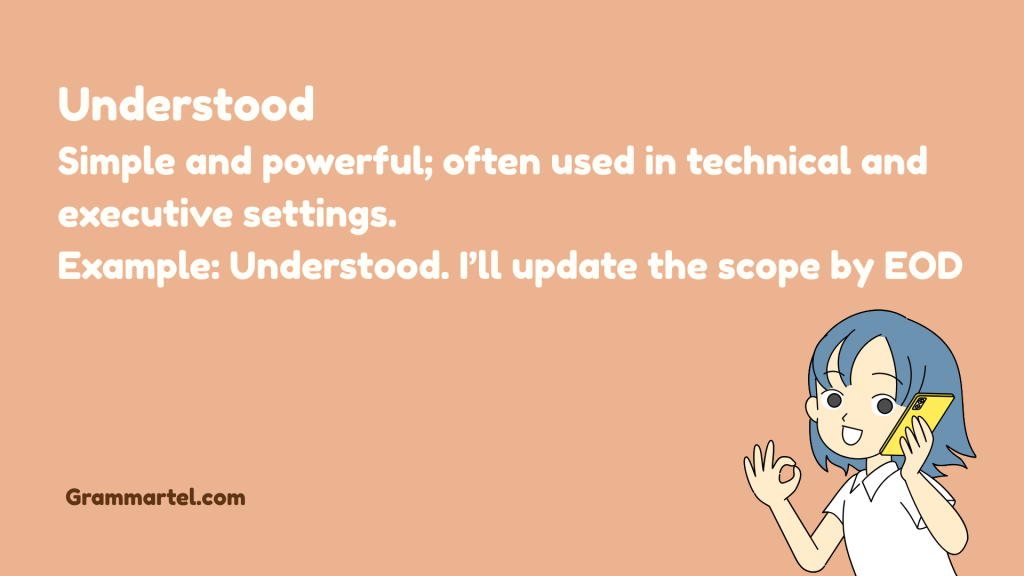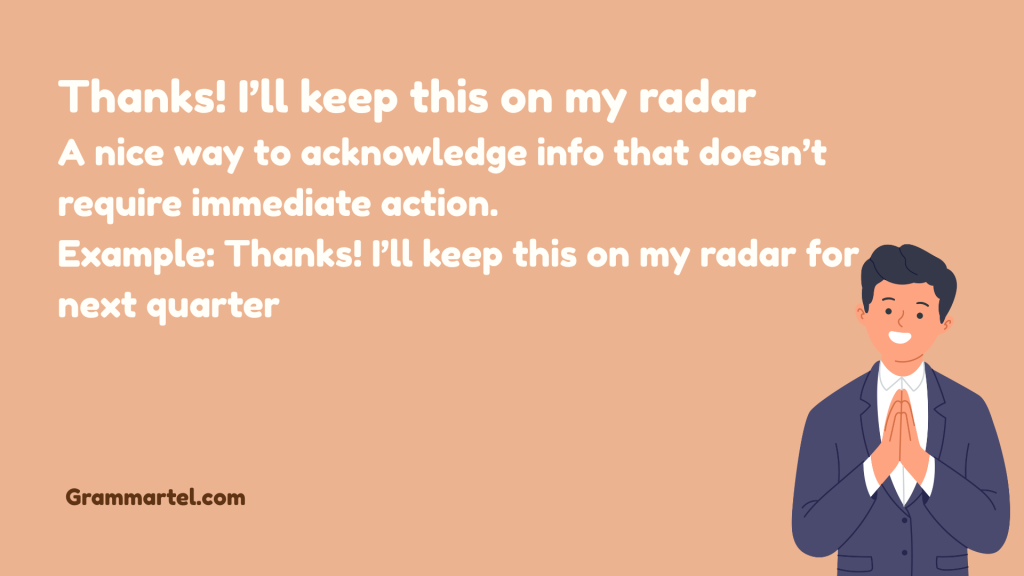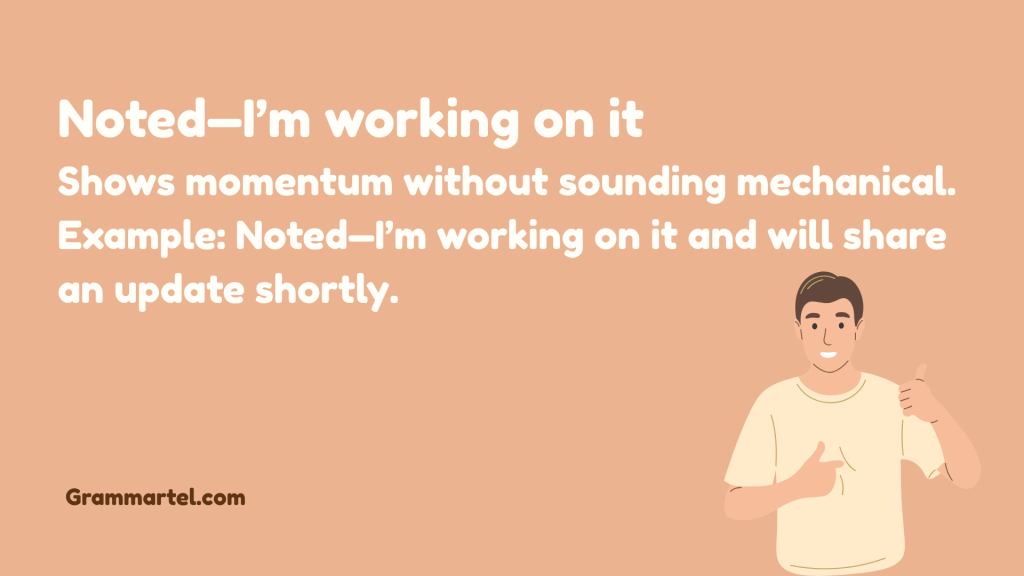Sometimes, saying “well noted” in an email feels stiff or overused. You’ve probably typed it without thinking, just to keep things polite and move on. But here’s the thing—your words matter, especially in business or work emails. They help build trust, show respect, and keep the tone right. So why not mix it up a bit? There are better, warmer, or even more direct ways to say it—depending on who you’re writing to. In this guide, you’ll find 40 simple, clear, and professional options to replace “well noted.” You might be surprised how much it changes the tone.
What Does “Well Noted” Mean in an Email?
“Well noted” is a short, formal phrase used to acknowledge that you’ve received and understood someone’s message. It’s common in professional emails, especially in legal, academic, or corporate environments. But here’s the thing—it often sounds robotic, overly formal, or emotionally flat. That’s fine in some industries, but in most work cultures today, a more natural or human response can go a long way.
When Should You Use It?
You can use “Well noted” (or a better version of it) when:
- You’re confirming receipt of info, tasks, or updates
- Someone shares feedback or instructions
- You want to show you’re aware, but don’t need to keep the conversation going
Avoid it when:
- You want to sound warm, personable, or collaborative
- The tone needs to match a friendlier or more casual dynamic
- You don’t want to come across as cold or dismissive
40 Better Alternatives to “Well Noted”
Professional & Formal
- Acknowledged
Very direct and formal; good for hierarchical or technical environments.
Example: Acknowledged. I’ll submit the report by Friday. - Received and understood
Shows you not only got the message but fully grasp it.
Example: Received and understood. We’ll revise the contract terms. - Noted with thanks
Polite and appreciative—used often in formal corporate communications.
Example: Noted with thanks. We’ll circulate the update internally. - I’ve taken note of your message
Slightly more human; implies you’ve made a record of it.
Example: I’ve taken note of your suggestions and will consider them. - Message received
Crisp, neutral, and often used in fast-paced, executive comms.
Example: Message received—we’ll factor this into tomorrow’s meeting. - I’ve made a note of it
Sounds attentive and professional without being stiff.
Example: Thanks—I’ve made a note of the change in schedule.

- Understood
Simple and powerful; often used in technical and executive settings.
Example: Understood. I’ll update the scope by EOD. - I’ll make the necessary adjustments
Adds an action element rather than just passive acknowledgment.
Example: Thanks—I’ll make the necessary adjustments to the plan. - Consider it done
Confident and action-forward. Great if you’re reassuring someone.
Example: Consider it done—I’ll handle the update personally. - Got it—thank you
Polished but still warm. Suitable across industries.
Example: Got it—thank you for the clarification.
New Ways: 30 Polite and Engaging Ways to Say How’s Your Day Going?
Warm & Personable
- Thanks, I’ve noted this
Slightly more human version of “Well noted” with gratitude.
Example: Thanks, I’ve noted this and will follow up tomorrow. - Thanks for letting me know—I’ve updated my records
Makes it clear you’ve processed and acted on the info.
Example: Thanks for letting me know—I’ve updated our system. - Appreciate the update—I’ll keep that in mind
Shows gratitude and attention to detail.
Example: Appreciate the update—I’ll keep that in mind during the rollout. - That’s helpful—thanks for the clarification
Great when someone clears up confusion or adds value.
Example: That’s helpful—thanks for the clarification on roles. - Got it! Appreciate you looping me in
Friendly and inclusive; great for team dynamics.
Example: Got it! Appreciate you looping me in on this project.

- Thanks! I’ll keep this on my radar
A nice way to acknowledge info that doesn’t require immediate action.
Example: Thanks! I’ll keep this on my radar for next quarter. - Heard and understood
A bit more empathetic, showing you’re listening fully.
Example: Heard and understood—we’ll handle it accordingly. - Perfect, I’ll make a note of it
Friendly, agreeable, and clear.
Example: Perfect, I’ll make a note of it for next time. - Thanks—I’ve made the necessary changes
Polished and proactive.
Example: Thanks—I’ve made the necessary changes to the doc. - Appreciated—this is noted on my end
Slightly formal, but adds a warm touch.
Example: Appreciated—this is noted on my end and shared with the team.
Action-Oriented & Clear
- I’ve added this to my to-do list
Concrete and helpful; shows it’s being tracked.
Example: I’ve added this to my to-do list for next week. - I’ll handle that accordingly
Confirms you’ve internalized the info and will take action.
Example: Thanks—I’ll handle that accordingly. - Action is underway—thanks
Reassuring and proactive.
Example: Action is underway—thanks for the heads-up. - Thanks—I’ve scheduled it
Specific and accountable.
Example: Thanks—I’ve scheduled the session for Thursday. - This is now in progress
Good for updates in response to a task or instruction.
Example: This is now in progress—we’ll share the draft soon.

- Noted—I’m working on it
Shows momentum without sounding mechanical.
Example: Noted—I’m working on it and will share an update shortly. - This is now logged and queued
Perfect for project managers, developers, or ticketing systems.
Example: This is now logged and queued for sprint planning. - All set on my end—thank you
A smooth way to confirm everything’s ready.
Example: All set on my end—thank you for your guidance. - Marked and tracked
Sounds very systems-based or operational.
Example: Marked and tracked—we’ll keep monitoring progress. - Will adjust plans accordingly
Great for strategy or planning conversations.
Example: Thanks for the update—we’ll adjust plans accordingly.
Don’t Miss It: 35 Professional Ways to Say ‘Congratulations to You Both’ (With Examples)
Casual & Friendly
- Cool, noted!
Light and casual; good for peer or team chat.
Example: Cool, noted! I’ll include that in the brief. - Alright, got it
Simple, everyday language—feels relaxed but respectful.
Example: Alright, got it. I’ll follow your lead. - Okay, that makes sense
Shows comprehension more than just acknowledgment.
Example: Okay, that makes sense—thanks for explaining. - Sounds good—I’ll go ahead with this
Confirms you’re ready to act.
Example: Sounds good—I’ll go ahead with the plan. - Sure thing—thanks for the info
Friendly and easygoing.
Example: Sure thing—thanks for the info, super helpful.

- Okay, thanks for flagging that
Useful when someone alerts you to an issue.
Example: Okay, thanks for flagging that—we’ll take care of it. - Gotcha—appreciate it
Very casual, works well for internal messages.
Example: Gotcha—appreciate it. I’ll handle it now. - Good to know—thanks!
Acknowledges info that’s more FYI than action-oriented.
Example: Good to know—thanks! That’ll help with planning. - That’s clear now—thanks!
Perfect for confirming clarity after confusion.
Example: That’s clear now—thanks! No further questions from me. - Yup, I’m on it
Short, casual, and full of momentum.
Example: Yup, I’m on it. Will circle back once it’s done.
Conclusion
Saying “well noted” works, but it can come off as cold or lazy. A small change in words can say a lot about how you listen, respect, and respond. Whether you’re talking to your boss, a client, or a teammate, there’s always a better way to show you’re paying attention. Try swapping in a few of these phrases next time. You’ll sound more natural, more human—and people will notice. It’s a small shift, but it makes a real difference. Sharpen Your Skills—Join the Grammartel Community Today.

